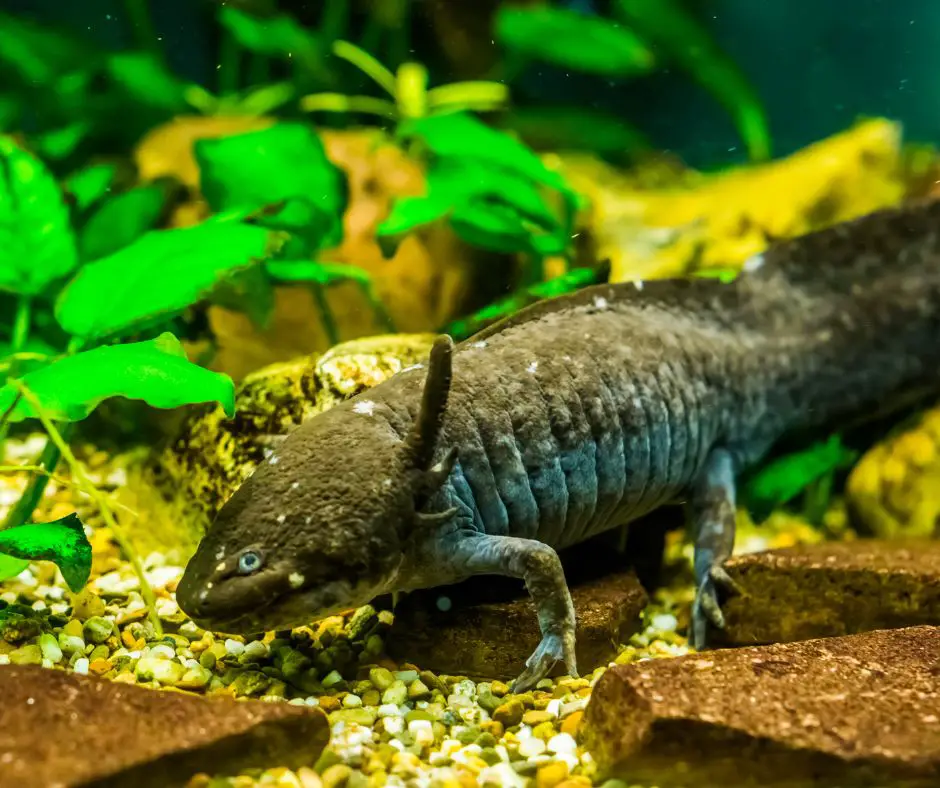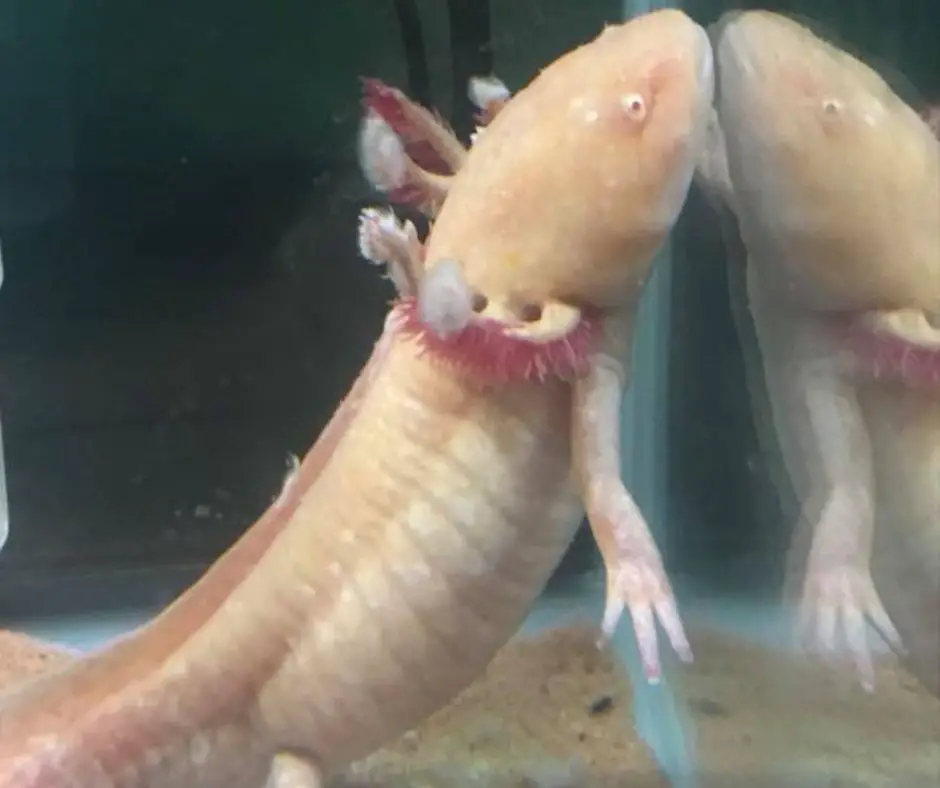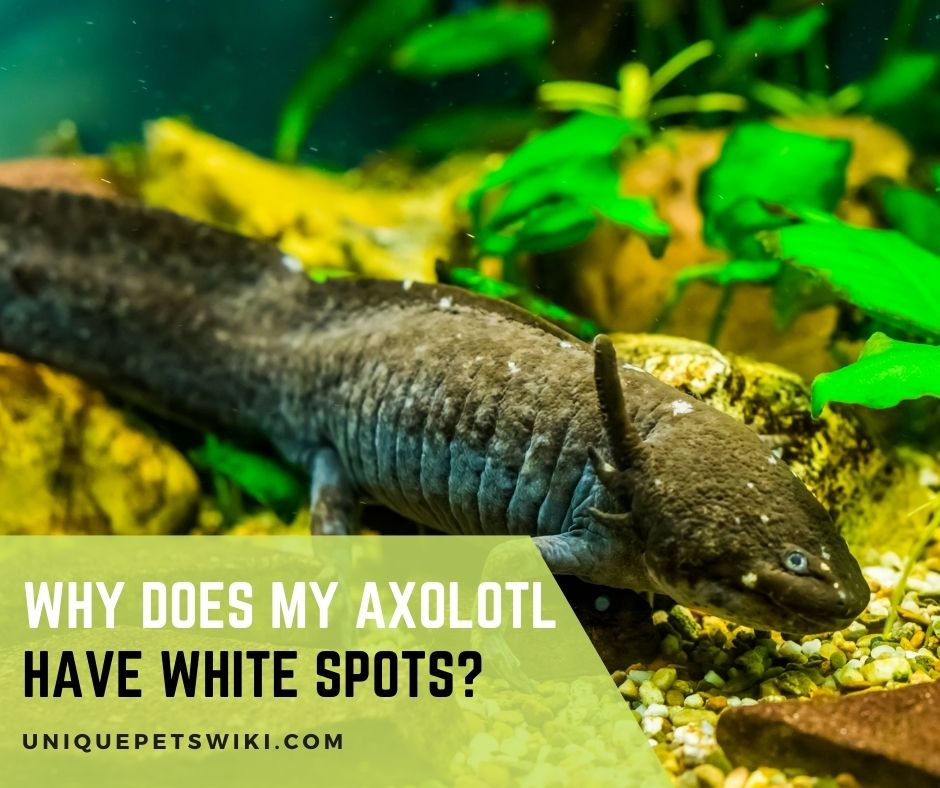Are you worried about white spots on your axolotl’s body? Well, the spots are likely caused by a fungal infection, and can be lethal. Fortunately, there are things you can do to treat the spots, and even prevent them from appearing in the first place.
Many axolotl owners—both beginners and experienced enthusiasts—simply do not know what to do when these white spots appear. Learning about this condition can help axolotl enthusiasts take better care of their axies.
In this post, we are going to discuss everything you need to know about axolotl white spots: their causes, symptoms, treatment options and preventative measures. .
Contents
Why Does My Axolotl Have White Spots?
White spots are usually caused by a fungus, and the condition can be fatal for axolotls.
This infection is often accompanied by other symptoms of illness such as nervousness, frequent intakes of surface air, refusal to eat, atrophied gills, injury, thinness, peeling skin, cotton ball in the gills, and swollen belly.
To treat the condition, separate the sick axolotl from healthy axolotls, reach out to a vet, and consider giving salt baths to the sick axolotl.

Yeast Infection
To know if it’s actually a yeast infection, look for accompanying signs such as opaque patches on the body, or white cottony balls in the gills.
Impropriator maintenance is the most likely cause of white fungus on gills.
The term “improper maintenance” can mean many things here, such as irregular cleaning of the tank, not changing the tank water, leaving the artificial plants unclean, not cleaning the uneaten food, and not using a water filter.
Yeast infections can also result from high water temperatures, or the presence of something acidic in the tank water. If your axolotl has a weak immune system, the animal is more susceptible to yeast infections.
The good news is there are a few things you can do to treat this condition. First, separate the sick axolotl from healthy ones. Check if the tank is clean enough. Clean the tank thoroughly. Pay attention to the hiding places, floor, and decor.
Check the pump flow. Also, make sure the temperature of the tank water is below 21°C. See this post to learn about some safe treatments for fungus.

It’s Called Vitiligo
Vitiligo is not a fungal infection, and not dangerous. The condition is of genetic origin, and manifested by a loss of pigment. Vitiligo occurs when an axolotl loses or deactivates melanophores. Dark pigment, which is actually melanin, disappears, leaving patches of gray or whitish skin.
Unless your axolotl shows other symptoms of illness, don’t worry about vitiligo. It’s not a disease; it’s just your axolotl’s color. There is no cure for the condition, but it’s not painful for your little friend.
Columnaris
Columnaris is an aerobic, gram-negative bacterium that grows and proliferates in freshwater. In a well-oxygenated, clean aquarium, columnaris can survive for up to a month. This bacterium does not, however, affect healthy animals. Old, young or stressed axolotls are particularly at risk.
Columnaris is potentially deadly, but if the infection is diagnosed in its early stages, it can be treated quite easily.
When an axolotl is affected by this disease, the animal becomes covered in gray or white patches. The axolotl will also become sluggish and lose its appetite.
A salt bath is a highly effective treatment for columnaris in axolotls. Apply one or two salt baths a day, each for about 10 minutes. If the skin condition is mild, your veterinarian may recommend a tea bath instead.
An aquatic vet may prescribe antibiotics if needed. MinnFinn, a broad-spectrum antiparasitic and antifungal product, is widely used to treat columnaris.
MinnFinn and NeuFinn Biodegradable Pond Treatment
- Natural Biodegradable Treatment
- Treat A Broad Spectrum of issues
- Easy To Dose In Ponds
Last update on 2022-12-29 / Affiliate links / Images from Amazon Product Advertising API
Axolotls Have Ich
White spots on your axolotl’s body may be an indicator of ichthyophthirius multifiliis—a condition which is also known as ich. Many species of fish also have ich, but axolotls show slightly different symptoms.
While fish tend to swim upside down when they have ich, axolotls don’t. They will still have white spots all over their bodies. Unless ich is very severe, it will not cause lesions. Ich will just suck on the animal’s skin.
In general, axolotls get ich from the fish they eat. That’s one of the reasons it’s so important to be careful when choosing feeder fish for your axolotl.
To treat axolotl ich, you have to contact a veterinarian. The vet may prescribe medications. A salt bath is an effective treatment for axolotl ich. The tank water should be changed regularly, as part of the treatment.
There are also several things you can do to prevent axolotl ich. Make sure the fish you feed to your axolotl doesn’t contain ich. If they do, you are risking your little friend’s health. Fish carry not only ich but also other disease-causing parasites and bacteria, and some of them can be fatal for axolotls.
How to Treat White Spots on Axolotls
In order to treat white spots on axolotls, it’s important to find the real cause of the condition. In most cases, these white spots are fungal infections caused by unhealthy tank conditions.
To find the root cause of the condition, examine the accompanying signs and symptoms. The treatment will be adequately effective only if the root cause is addressed. To address the issue effectively, learn more about axolotl fungus treatment. See a veterinarian diagnose the condition accurately.
If white spots are diagnosed in the early stages, the condition is treatable in most cases. The only exception is vitiligo, which is not an infection.
How to Prevent White Spots on Axolotls
Keep the tank water clean, Do a 20% water change every week. Whenever you spot axolotl poop or leftover food, clean it. Spot cleaning is the best way to keep the tank environment clean. Use a turkey baster to spot clean the tank. This device can also be used to feed your axolotl.
Use a water conditioner to remove chlorine. Chlorine can wreak havoc on the tank’s nitrogen cycle. Do not completely empty the tank. If you do so, the tank will lose its cycle. Consider investing in an aquarium gravel cleaner and use it to remove waste.
Laifoo Aquarium Siphon Vacuum Cleaner for Fish Tank Cleaning Gravel & Sand
- FUNCTION --- Easy to control, convenient to siphon fish faeces, impurities, turbid water out of fish tank.
- 5 Feet HOSE --- Made from clear & elastic plastic. Makes it more durable and anti-kinking. Harmless to fishes & No peculiar smell.
- GRAVEL TUBE --- Sinkable, with a detachable filter screen inside. Will not disturb fish or decor when it's working.
- SIPHON BALL --- All you need to do is to pinch it several times, water will flow out automatically. Without striking a blowing.
- WARRANTY --- For 3 months after the date of purchase, we take care of all quality-related issues with a FREE replacement or refund. If you have any questions, do not hesitate to contact our professional after-sale service.
Last update on 2022-12-29 / Affiliate links / Images from Amazon Product Advertising API
It is important to use the tank water when cleaning or rinsing the filter and other tank ornaments. Tap water can destroy the tank’s nitrogen cycle. The beneficial bacteria build up in the filter, so be careful when cleaning the filter.
Regularly check the water parameters with a test kit. Make sure the ammonia, nitrite, nitrate and pH levels are within the normal range.
Also, feed your axolotl properly to improve the animal’s immune system. In the wild axolotls eat worms, larvae, small fish, and mollusks. In captivity, axolotls are fed blackworms, nightcrawlers, raw meat, daphnia, pellets and brine shrimp. The diet should contain 30-60% protein.
Before you put aquatic creatures in the tank, make sure they do not carry parasites that may cause infections such as ich and columnaris. Ideally, you should breed feeder fish for your axolotl.
API Water Test Kit
- Contains one (1) API FRESHWATER MASTER TEST KIT 800-Test Freshwater Aquarium Water Master Test Kit, including 7 bottles of testing solutions, 1 color card and 4 glass tubes with cap
- Helps monitor water quality and prevent invisible water problems that can be harmful to fish and cause fish loss
- Accurately monitors 5 most vital water parameters levels in freshwater aquariums: pH, high range pH, ammonia, nitrite, nitrate
- Designed for use in freshwater aquariums only
- Use for weekly monitoring and when water or fish problems appear
Last update on 2022-12-30 / Affiliate links / Images from Amazon Product Advertising API
Conclusion
Axolotls make great pets, but those with weak immunity, even healthy ones, are prone to bacterial infections.
If you notice white spots on your axolotl’s body, the first thing you have to do is to separate the sick axolotl from healthy ones. Then contact a vet if needed, figure out the underlying cause, and address the issue before it gets out of control.
The good news is there are preventative measures that actually work. You can significantly reduce the risk of fungal infections just by being careful about what you put in the tank and keeping the tank environment clean.



